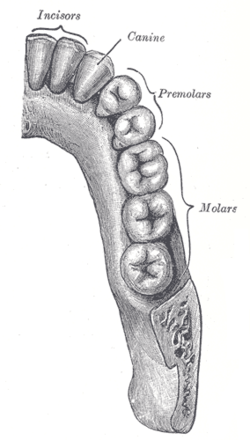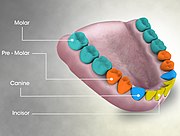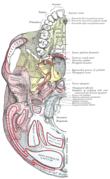Premolar
| Premolar | |
|---|---|
 The permanent teeth, viewed from the right. | |
 Permanent teeth of right half of lower dental arch, seen from above. | |
| Details | |
| Identifiers | |
| Latin | dentes premolares |
| MeSH | D001641 |
| TA98 | A05.1.03.006 |
| TA2 | 909 |
| FMA | 55637 |
| Anatomical terminology | |
The premolar teeth, or bicuspids, are transitional teeth located between the canine and molar teeth. In humans, there are two premolars per quadrant in the permanent set of teeth, making eight premolars total in the mouth.[1][2][3] They have at least two cusps. Premolars can be considered as 'transitional teeth' during chewing, or mastication. They have properties of both the anterior canines and posterior molars, and so food can be transferred from the canines to the premolars and finally to the molars for grinding, instead of directly from the canines to the molars.[4]
The premolars in humans are the maxillary first premolar, maxillary second premolar, mandibular first premolar, and the mandibular second premolar.[1][3]
There is always one large buccal cusp, especially so in the mandibular first premolar. The lower second premolar almost always presents with two lingual cusps.[5]
Molar teeth by definition are permanent teeth distal to the canines, preceded by deciduous premolars.[6] In primitive placental mammals there are four premolars per quadrant, but the most mesial two (closer to the front of the mount) have been lost in catarrhines (Old World monkeys and apes, including humans). Paleontologists therefore refer to human premolars as Pm3 and Pm4.[7][8]
Additional images
See also
References
- ^ a b Gray’s Anatomy (35th ed.), London: Longman, 1973, pp. 1218–1220
{{citation}}: Unknown parameter|editors=ignored (|editor=suggested) (help) - ^ Weiss, M.L., & Mann, A.E (1985), Human Biology and Behaviour: An anthropological perspective (4th ed.), Boston: Little Brown, pp. 132–135, 198–199, ISBN 0-673-39013-6
{{citation}}: CS1 maint: multiple names: authors list (link) - ^ a b Mosby's Medical, Nursing & Allied Health Dictionary (3rd ed.), St. Louis, Missouri: The C.V. Mosby Co., 1990, p. 957, ISBN 0-8016-3227-7
{{citation}}: Unknown parameter|editors=ignored (|editor=suggested) (help) - ^ Weiss, M.L., & Mann, A.E. (1985), pp.132-134
- ^ Warwick, R., & Williams, P.L. (1973), p.1219.
- ^ Warwick, R., & Williams, P.L. (1973), pp.1218-1219.
- ^ Christopher Dean (1994). "Jaws and teeth". The Cambridge Encyclopedia of Human Evolution. Cambridge: Cambridge University Press. pp. 56–59. ISBN 0-521-32370-3.
{{cite book}}: Unknown parameter|editors=ignored (|editor=suggested) (help) Also ISBN 0-521-46786-1 (paperback) - ^ Gentry Steele and Claud Bramblett (1988). The Anatomy and Biology of the Human Skeleton. p. 82. ISBN 9780890963265.




